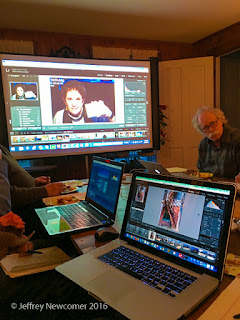 |
| Around the Table |
This week I finally finished my Lightroom Course. I had planned for four 2 hour sessions, but the first time you run a course it is impossible to reliably predict how long it will take to cover all the material. I was fortunate to have a lovely group whose intense interest in mastering this remarkable tool led to lots of questions. I told them from the beginning that extend the course to five or more sessions if required and it turned out that five was barely enough.

From the beginning, this course was an experiment. I had previously offered my Introduction to Digital Photography Course, through Keene Community Education, at the High School. The classroom worked well, but it was not an especially comfortable
 |
| Perspective Control |
 |
| Pre-cooked HDR |

 |
| Terrible Image |
I don't mean to suggest that all of this was an arduous procedure. I love introducing people to the magic of Lightroom and join in their excitement over the discovery of unexpected features. I always stress the importance of getting the best images from the camera, but the most effective examples of the power of Lightroom often started as the worst pictures. I picked a horribly back-lit image of Abigail and Grayson from Gay Head on Martha's Vineyard and was able to demonstrate how highlights, shadows and color could all be salvaged from the RAW image.
 |
| With Apologies to Photographic Purists. But it Made the Point. |
 |
| Pet Eye Correction |
From the feedback, I think that everyone enjoyed the course and came away with a better appreciation of the power and capabilities of Lightroom. Most importantly I believe understand what is possible and even if they don't remember the details of how to do something, they now know where to look. They learned how to organize their images, how to back them up and how they can get the most from every pixel. They also know my phone number for when they get completely flummoxed.
As always when I set out to teach something I ended up learning much more than I could teach:
Before I started preparing for the course I only truly understood those parts of Lightroom that were required for my own narrow
 |
| Local Adjustment Tools |
Before the class I had done a few slide shows from Lightroom, but now I have a better feel for this tool along with the Book and Web Modules. Since I typically move images to Photoshop I will continue to use the program for printing, but I now feel that Lightroom offers a reasonable alternative.
Lessons Learned
I am already getting questions about when. I will offer the Lightroom course again, and the questions is what have I learned from this class and what changes would I make?
Home Cooking
 The first question is whether it worked to offer the course from around my dining room table. Running the class from home has some disadvantages. The class size was limited and it did require participants to slog all the way out to Spofford each evening. For Keene people Chesterfield might as well be in a different time zone! On the positive side, I liked the fact that a small class allowed a relaxed atmosphere in which questions could be welcomed. Ten was more than I originally expected, but we were able to get everyone at the table with room for their laptops. The drive didn't seem to be a major issue and not having to pay for a venue in town meant that I could keep the price down. Besides the home environment made it easy to provide delicious snacks.
The first question is whether it worked to offer the course from around my dining room table. Running the class from home has some disadvantages. The class size was limited and it did require participants to slog all the way out to Spofford each evening. For Keene people Chesterfield might as well be in a different time zone! On the positive side, I liked the fact that a small class allowed a relaxed atmosphere in which questions could be welcomed. Ten was more than I originally expected, but we were able to get everyone at the table with room for their laptops. The drive didn't seem to be a major issue and not having to pay for a venue in town meant that I could keep the price down. Besides the home environment made it easy to provide delicious snacks. Laptop Distractions
 |
| Basic Panel Adjustments |
Working on the Same Stuff
In future classes I may give the students a disk with my working files. I encouraged everyone to try techniques on their own images, but it may be easier to work on the same files. Another student was disappointed that I didn't take time to critique examples of everyone's work. I have done this in by Introduction to Digital Photography Course, but it became obvious that the amount of material that I had to cover was so vast that I didn't have the time to review everyone's work. It might be helpful to schedule a separate critique session a few weeks after the course ends, to evaluate how everyone is doing and answer the inevitable questions.
 |
| Mount Washington Hotel Panorama |
Time
 As I prepared my course, I had no idea how much time would be needed to cover the essentials of such a vastly capable program as Lightroom. As I mentioned, I initially scheduled four sessions to last two hours each, but prior to the course, I alternately jumped from fear that I had too little, or too much, material to fill the allotted eight hours. I shouldn't have been surprised that I ended up adding a fifth class to try get everything covered. In the future I'll know to schedule at least five sessions.
As I prepared my course, I had no idea how much time would be needed to cover the essentials of such a vastly capable program as Lightroom. As I mentioned, I initially scheduled four sessions to last two hours each, but prior to the course, I alternately jumped from fear that I had too little, or too much, material to fill the allotted eight hours. I shouldn't have been surprised that I ended up adding a fifth class to try get everything covered. In the future I'll know to schedule at least five sessions.The one thing that I did not find surprising was how much fun it was to spend evenings sharing my excitement for a topic that was of such intense interest to this group of enthusiastic and engaged students. I can't imagine a nicer group, but I'm sure I will give it another try some time soon
Jeffrey Newcomer
Partridgebrookreflections.com

These photographs are professional .
ReplyDelete